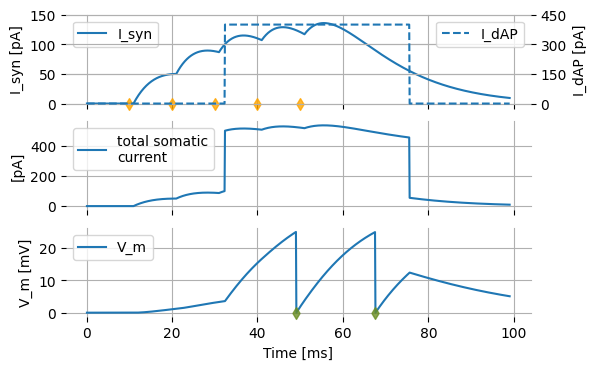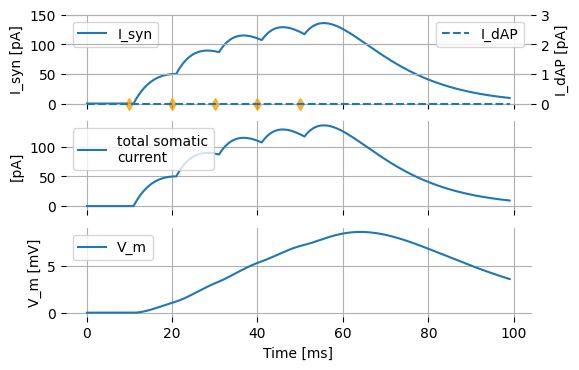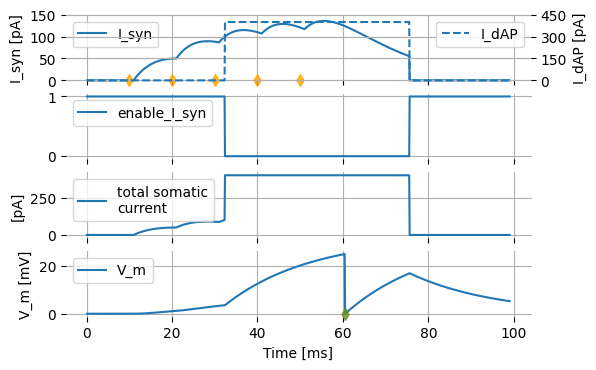NESTML active dendrite tutorial
In this tutorial, we create a neuron model with a “nonlinear” or “active” dendritic compartment, that can, independently from the soma, generate a dendritic action potential. Instead of modeling the membrane potential of the dendritic compartment explicitly, the dendritic action potential (dAP) is modeled here as the injection of a rectangular (pulse shaped) dendritic current into the soma, parameterized by an amplitude and a duration. The rectangular shape can be interpreted as the approximation of an NMDA spike (Antic et al. 2010). A dendritic action potential is triggered when the total synaptic current exceeds a threshold.
The model we are building is an adapted version of the neuron model introduced by Memmesheimer et al. (2012) and Jahnke et al. (2012).
Table of contents
[1]:
%matplotlib inline
import matplotlib as mpl
import matplotlib.pyplot as plt
import nest
import numpy as np
import os
from pynestml.frontend.pynestml_frontend import to_nest, install_nest
NEST_SIMULATOR_INSTALL_LOCATION = nest.ll_api.sli_func("statusdict/prefix ::")
Adding dAP current to the model
We will use a standard, linear integrate-and-fire neuron with the governing equation:
Here, the term \(I_{syn}\) contains all the currents flowing into the soma due to synaptic input, and \(I_{dAP}\) contains the contribution of a dendritic action potential.
Implementing the pulse shape
The dAP current is modeled here as a rectangular (pulse) function, parameterized by an amplitude (current strength) and width (duration).
parameters:
I_dAP_peak pA = 150 pA # current clamp value for I_dAP during a dendritic action potential
T_dAP ms = 10 ms # time window over which the dendritic current clamp is active
...
We also define a synaptic current threshold that, when crossed, initiates the dendritic action potential:
parameters:
I_th pA = 100 pA # current threshold for a dendritic action potential
...
The current is switched on and off as follows. When a dendritic action potential is triggered, the magnitude of the I_dAP current is set to I_dAP_peak, and a timer variable t_dAP is set to the duration of the current pulse, T_dAP. At each future run of the NESTML update block, the timer is decremented until it reaches 0, at which point the dendritic action potential current I_dAP is set back to zero.
update:
if t_dAP > 0 ms:
# during a dendritic action potential pulse
t_dAP -= resolution()
if t_dAP <= 0 ms:
# end of dendritic action potential
I_dAP = 0 pA
t_dAP = 0 ms
end
end
if I_syn > I_th:
# current-threshold, emit a dendritic action potential
t_dAP = T_dAP
I_dAP = I_dAP_peak
end
The complete neuron model is as follows:
[2]:
nestml_active_dend_model = '''
neuron iaf_psc_exp_active_dendrite:
state:
V_m mV = 0 mV # membrane potential
t_dAP ms = 0 ms # dendritic action potential timer
I_dAP pA = 0 pA # dendritic action potential current magnitude
end
equations:
# alpha shaped postsynaptic current kernel
kernel syn_kernel = (e / tau_syn) * t * exp(-t / tau_syn)
recordable inline I_syn pA = convolve(syn_kernel, spikes_in)
V_m' = -(V_m - E_L) / tau_m + (I_syn + I_dAP + I_e) / C_m
end
parameters:
C_m pF = 250 pF # capacity of the membrane
tau_m ms = 20 ms # membrane time constant
tau_syn ms = 10 ms # time constant of synaptic current
V_th mV = 25 mV # action potential threshold
V_reset mV = 0 mV # reset voltage
I_e pA = 0 pA # external current
E_L mV = 0 mV # resting potential
# dendritic action potential
I_th pA = 100 pA # current threshold for a dendritic action potential
I_dAP_peak pA = 150 pA # current clamp value for I_dAP during a dendritic action potential
T_dAP ms = 10 ms # time window over which the dendritic current clamp is active
end
input:
spikes_in pA <- spike
end
output: spike
update:
# solve ODEs
integrate_odes()
if t_dAP > 0 ms:
t_dAP -= resolution()
if t_dAP <= 0 ms:
# end of dendritic action potential
t_dAP = 0 ms
I_dAP = 0 pA
end
end
if I_syn > I_th:
# current-threshold, emit a dendritic action potential
t_dAP = T_dAP
I_dAP = I_dAP_peak
end
# emit somatic action potential
if V_m > V_th:
emit_spike()
V_m = V_reset
end
end
end
'''
Save to a temporary file and make the model available to instantiate in NEST (see Running NESTML):
[3]:
with open("iaf_psc_exp_active_dendrite.nestml", "w") as nestml_model_file:
print(nestml_active_dend_model, file=nestml_model_file)
to_nest(input_path="iaf_psc_exp_active_dendrite.nestml",
target_path="/tmp/nestml-active-dend-target",
module_name="nestml_active_dend_module",
suffix="_nestml",
logging_level="ERROR") # try "INFO" for more debug information
install_nest("/tmp/nestml-active-dend-target", NEST_SIMULATOR_INSTALL_LOCATION)
nest.Install("nestml_active_dend_module")
Running the simulation in NEST
Let’s define a function that will instantiate the active dendrite model, run a simulation, and plot and return the results.
[4]:
def evaluate_neuron(neuron_name, neuron_parms=None, t_sim=100., plot=True):
"""
Run a simulation in NEST for the specified neuron. Inject a stepwise
current and plot the membrane potential dynamics and action potentials generated.
"""
dt = .1 # [ms]
nest.ResetKernel()
try:
nest.Install("nestml_active_dend_module")
except :
pass
neuron = nest.Create(neuron_name)
if neuron_parms:
for k, v in neuron_parms.items():
nest.SetStatus(neuron, k, v)
sg = nest.Create("spike_generator", params={"spike_times": [10., 20., 30., 40., 50.]})
multimeter = nest.Create("multimeter")
record_from_vars = ["V_m", "I_syn", "I_dAP"]
if "enable_I_syn" in neuron.get().keys():
record_from_vars += ["enable_I_syn"]
multimeter.set({"record_from": record_from_vars,
"interval": dt})
sr_pre = nest.Create("spike_recorder")
sr = nest.Create("spike_recorder")
nest.Connect(sg, neuron, syn_spec={"weight": 50., "delay": 1.})
nest.Connect(multimeter, neuron)
nest.Connect(sg, sr_pre)
nest.Connect(neuron, sr)
nest.Simulate(t_sim)
mm = nest.GetStatus(multimeter)[0]
timevec = mm.get("events")["times"]
I_syn_ts = mm.get("events")["I_syn"]
I_dAP_ts = mm.get("events")["I_dAP"]
ts_somatic_curr = I_syn_ts + I_dAP_ts
if "enable_I_syn" in mm.get("events").keys():
enable_I_syn = mm.get("events")["enable_I_syn"]
ts_somatic_curr = enable_I_syn * I_syn_ts + I_dAP_ts
ts_sp = nest.GetStatus(sr, keys='events')[0]['times']
ts_pre_sp = nest.GetStatus(sr_pre, keys='events')[0]['times']
if plot:
n_subplots = 3
n_ticks = 4
if "enable_I_syn" in mm.get("events").keys():
n_subplots += 1
fig, ax = plt.subplots(n_subplots, 1, dpi=100)
ax[0].scatter(ts_pre_sp, np.zeros_like(ts_pre_sp), marker="d", c="orange", alpha=.8, zorder=99)
ax[0].plot(timevec, I_syn_ts, label=r"I_syn")
ax[0].set_ylabel("I_syn [pA]")
ax[0].set_ylim(0, np.round(1.1*np.amax(I_syn_ts)/50)*50)
ax[0].yaxis.set_major_locator(mpl.ticker.LinearLocator(n_ticks))
twin_ax = ax[0].twinx()
twin_ax.plot(timevec, I_dAP_ts, linestyle="--", label=r"I_dAP")
twin_ax.set_ylabel("I_dAP [pA]")
twin_ax.set_ylim(0, max(3, np.round(1.1*np.amax(I_dAP_ts)/50)*50))
twin_ax.legend(loc="upper right")
twin_ax.yaxis.set_major_locator(mpl.ticker.LinearLocator(n_ticks))
ax[-2].plot(timevec, ts_somatic_curr, label="total somatic\ncurrent")
ax[-2].set_ylabel("[pA]")
if "enable_I_syn" in mm.get("events").keys():
ax[1].plot(timevec, enable_I_syn, label="enable_I_syn")
ax[1].set_ylim([-.05, 1.05])
ax[1].set_yticks([0, 1])
ax[-1].plot(timevec, mm.get("events")["V_m"], label="V_m")
ax[-1].scatter(ts_sp, np.zeros_like(ts_sp), marker="d", c="olivedrab", alpha=.8, zorder=99)
ax[-1].set_ylabel("V_m [mV]")
ax[-1].set_xlabel("Time [ms]")
for _ax in set(ax) | set([twin_ax]):
_ax.grid()
if not _ax == twin_ax: _ax.legend(loc="upper left")
if not _ax == ax[-1]: _ax.set_xticklabels([])
for _loc in ['top', 'right', 'bottom', 'left']: _ax.spines[_loc].set_visible(False) # hide axis outline
for o in fig.findobj(): o.set_clip_on(False) # disable clipping
fig.show()
[5]:
evaluate_neuron("iaf_psc_exp_active_dendrite_nestml", neuron_parms={"I_th": 100., "I_dAP_peak": 400.})

In the top panel, we can see the synaptic and dAP currents separately. Incoming action potentials from the presynaptic partner, triggering postsynaptic currents, are indicated by orange diamonds ♦. The middle panel shows the total synaptic current, which is equal to the sum of synaptic and dendritic action potential current. The bottom panel shows the resulting postsynaptic membrane potential, and postsynaptic (somatic) action potentials using green diamonds ♦.
The presynaptic action potentials by themselves are not sufficient by themselves to trigger a postsynaptic action potential, which can be seen by setting the dAP threshold to a very high value, preventing it from triggering. No postsynaptic spikes are observed.
[6]:
evaluate_neuron("iaf_psc_exp_active_dendrite_nestml", neuron_parms={"I_th": 9999.})

Dynamically controlling synaptic integration
We now add the additional requirement for the dendritic action potential to disable synaptic integration. When a dendritic action potential happens, we want to ignore synaptic currents for the duration of the action potential, and to reset the synaptic currents such that any presynaptic activity before the dendritic action potential is ignored.
To do this, we add a state variable enable_I_syn, that will have the value 1 if synaptic current integration is enabled, and 0 in case it is disabled. This variables multiplies the I_syn term in the differential equation for \(V_m\). The new governing equation is then:
We can then temporarily disable the synaptic current from contributing to the update of V_m by setting enable_I_syn to zero, for instance:
update:
if I_syn > I_th:
# current-threshold, emit a dendritic action potential
...
# temporarily pause synaptic integration
enable_I_syn = 0.
...
In order to ignore presynaptic input that arrives during and before a dendritic action potential, we use the inline aliasing feature of NESTML. Usually, synaptic integration is expressed as a convolution, for example:
equations:
kernel syn_kernel = exp(-t / tau_syn)
V_m' = -(V_m - E_L) / tau_m + convolve(syn_kernel, in_spikes) / C_m
...
We will define an inline expression that aliases this convolution (see https://nestml.readthedocs.io/en/latest/nestml_language.html#%28Re%29setting-synaptic-integration-state for a more detailed explanation):
equations:
inline I_syn pA = convolve(syn_kernel, in_spikes)
...
Now, we can not only use the variable I_syn in expressions, but we can also assign to it. To reset the state of synaptic integration (thereby “forgetting” any past action potential events):
update:
...
if t_dAP <= 0 ms:
# end of dendritic action potential
...
I_syn = 0 pA
I_syn' = 0 pA/ms
...
end
end
Putting it all together in a new model, we have:
[7]:
nestml_active_dend_reset_model = '''
neuron iaf_psc_exp_active_dendrite_resetting:
state:
V_m mV = 0 mV # membrane potential
t_dAP ms = 0 ms # dendritic action potential timer
I_dAP pA = 0 pA # dendritic action potential current magnitude
enable_I_syn real = 1. # set to 1 to allow synaptic currents to
# contribute to V_m integration, 0 otherwise
end
equations:
# alpha shaped postsynaptic current kernel
kernel syn_kernel = (e / tau_syn) * t * exp(-t / tau_syn)
recordable inline I_syn pA = convolve(syn_kernel, spikes_in)
V_m' = -(V_m - E_L) / tau_m + (enable_I_syn * I_syn + I_dAP + I_e) / C_m
end
parameters:
C_m pF = 250 pF # capacity of the membrane
tau_m ms = 20 ms # membrane time constant
tau_syn ms = 10 ms # time constant of synaptic current
V_th mV = 25 mV # action potential threshold
V_reset mV = 0 mV # reset voltage
I_e pA = 0 pA # external current
E_L mV = 0 mV # resting potential
# dendritic action potential
I_th pA = 100 pA # current-threshold for a dendritic action potential
I_dAP_peak pA = 150 pA # current clamp value for I_dAP during a dendritic action potential
T_dAP ms = 10 ms # time window over which the dendritic current clamp is active
end
input:
spikes_in pA <- spike
end
output: spike
update:
# solve ODEs
integrate_odes()
if t_dAP > 0 ms:
t_dAP -= resolution()
if t_dAP <= 0 ms:
I_dAP = 0 pA
t_dAP = 0 ms
# reset and re-enable synaptic integration
I_syn = 0 pA
I_syn' = 0 pA/ms
enable_I_syn = 1.
end
end
if I_syn > I_th:
# current-threshold, emit a dendritic action potential
t_dAP = T_dAP
I_dAP = I_dAP_peak
# temporarily pause synaptic integration
enable_I_syn = 0.
end
# emit somatic action potential
if V_m > V_th:
emit_spike()
V_m = V_reset
end
end
end
'''
Save to a temporary file and make the model available to instantiate in NEST (see Running NESTML):
[8]:
with open("iaf_psc_exp_active_dendrite.nestml", "w") as nestml_model_file:
print(nestml_active_dend_reset_model, file=nestml_model_file)
to_nest(input_path="iaf_psc_exp_active_dendrite.nestml",
target_path="/tmp/nestml-active-dend-target",
module_name="nestml_active_dend_reset_module",
suffix="_nestml",
logging_level="ERROR") # try "INFO" for more debug information
install_nest("/tmp/nestml-active-dend-target", NEST_SIMULATOR_INSTALL_LOCATION)
nest.Install("nestml_active_dend_reset_module")
If we run the simulation with the same parameters as last time, we now observe only one instead of two action potentials, because the synaptic current (shown as I_syn in the top subplot below) does not contribute to V_m during the dendritic action potential interval.
[9]:
evaluate_neuron("iaf_psc_exp_active_dendrite_resetting_nestml",
neuron_parms={"I_th": 100., "I_dAP_peak": 400.})

Acknowledgements
We extend our gratitude to Younes Bouhadjar and Tom Tetzlaff for their contributions.
This software was developed in part or in whole in the Human Brain Project, funded from the European Union’s Horizon 2020 Framework Programme for Research and Innovation under Specific Grant Agreements No. 720270 and No. 785907 (Human Brain Project SGA1 and SGA2).
References
Jahnke, S., Timme, M. & Memmesheimer, R. M. (2012). Guiding synchrony through random networks. Physical Review X, 2(4), 041016. https://doi.org/10.1103/PhysRevX.2.041016
Memmesheimer, R. M. & Timme, M. (2012). Non-additive coupling enables propagation of synchronous spiking activity in purely random networks. PLoS Comput Biol, 8(4), e1002384. https://doi.org/10.1371/journal.pcbi.1002384
Antic, S.D. Zhou, W.-L., Moore, A.R., Short, S.M., & Ikonomu, K.D. (2010). The Decade of the Dendritic NMDA Spike. J Neurosci Res. Nov 1, 88(14). https://doi.org/10.1002/jnr.22444
Copyright
This file is part of NEST.
Copyright (C) 2004 The NEST Initiative
NEST is free software: you can redistribute it and/or modify it under the terms of the GNU General Public License as published by the Free Software Foundation, either version 2 of the License, or (at your option) any later version.
NEST is distributed in the hope that it will be useful, but WITHOUT ANY WARRANTY; without even the implied warranty of MERCHANTABILITY or FITNESS FOR A PARTICULAR PURPOSE. See the GNU General Public License for more details.
You should have received a copy of the GNU General Public License along with NEST. If not, see http://www.gnu.org/licenses/.